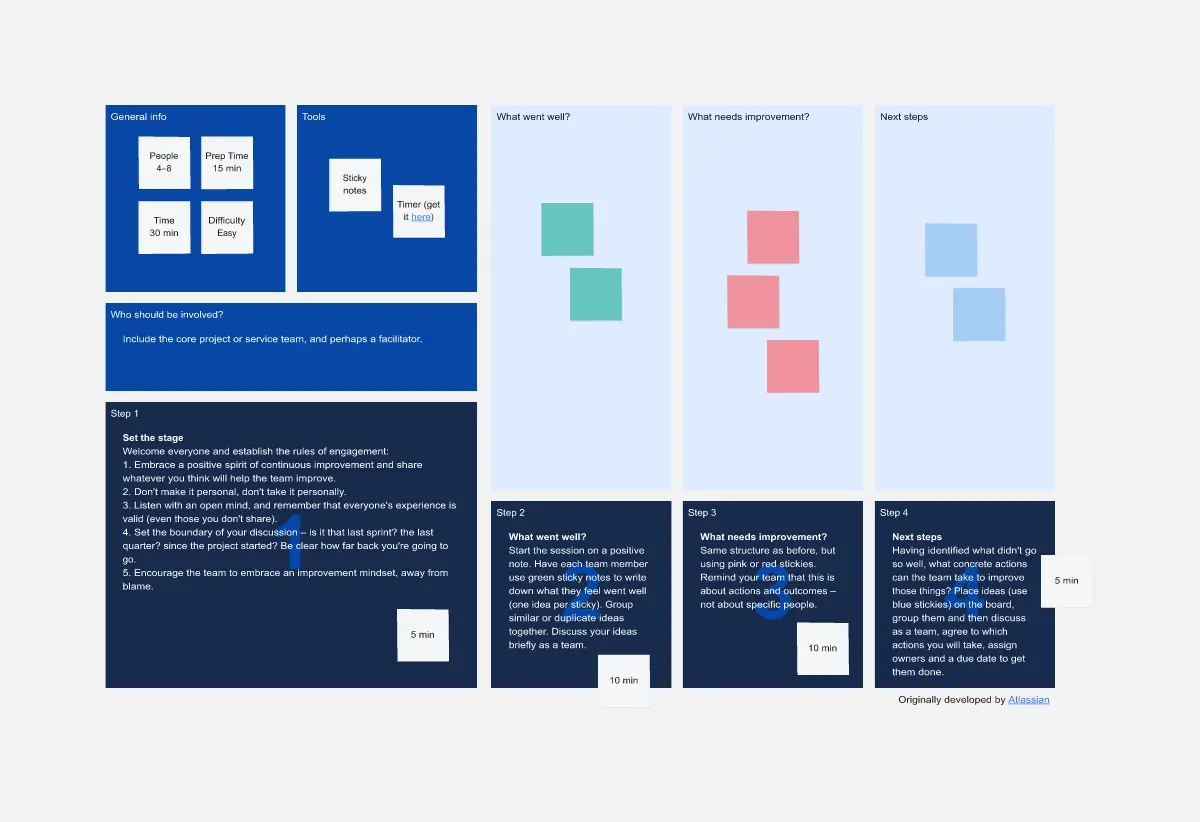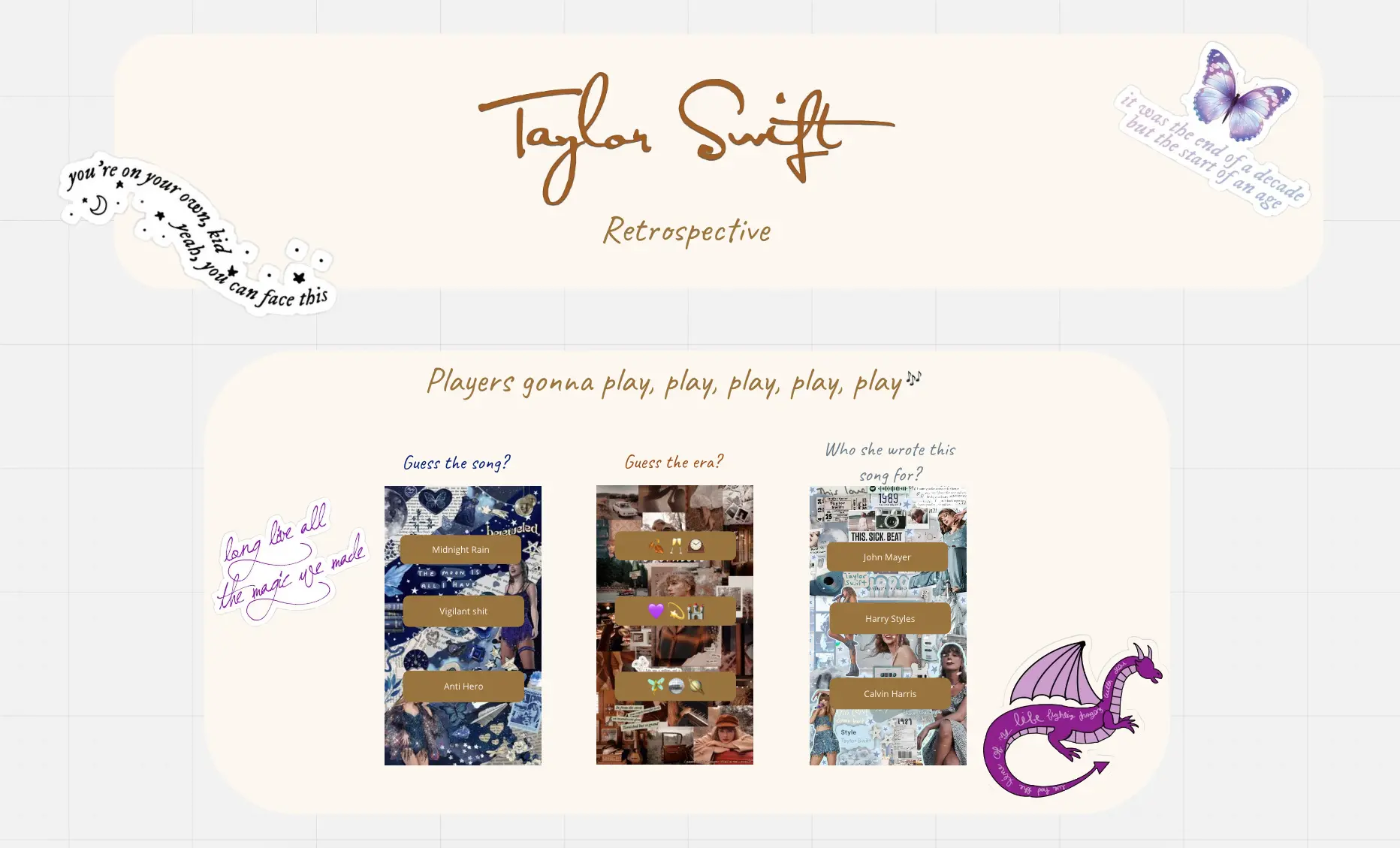The Team Topologies retrospective template provides a comprehensive framework for agile teams to reflect on their structure, collaboration, and effectiveness. Equipped with the principles of Team Topologies by Matthew Skelton and Manuel Pais, this retrospective template aims to facilitate meaningful discussions and drive improvements in workflow and delivery.
How to use this template
Follow the steps below to get the most of this framework:
Step 1: Start with the icebreaker
This activity sets the stage for the main discussion and encourages participants to reflect on their team's fit within the four core topologies identified in the book: Stream-aligned, Enabling, Complicated-subsystem, or Platform.
Step 2: Core retrospective discussion
After completing the icebreaker activity, move to the main board for the core retrospective discussion. Here, you will find various topics related to Team Topologies, such as stream-aligned teams, enabling teams, platform teams, and complicated-subsystem teams. Each topic provides a description of its purpose and characteristics, offering valuable insights into different team structures and their impact on product development.
Key discussion topics
To guide your retrospective discussions, this template offers several key discussion topics organized under relevant headers:
Cognitive Load Check-In: Reflect on your team's current cognitive load and identify areas where you can shed or adopt practices to achieve a better balance. This discussion helps optimize productivity and prevent burnout.
Services & Interactions: Consider your team as an API and identify the "endpoints" of your interactions with other teams. Discuss how you can make these endpoints clearer and more efficient, fostering seamless collaboration.
Conway's Law Analysis: Explore how your team's structure influences the design of your product or service. Evaluate whether the current structure aligns with your goals and identify opportunities for improvement.
Facilitation & Obstacles: Reflect on recent experiences of seeking help from other teams to overcome obstacles. Discuss the effectiveness of these interactions and brainstorm ways to enhance collaboration and support infrastructure.
Value Stream Alignment: Assess your team's alignment with specific value streams and analyze how this alignment impacts your work and delivery. Identify any misalignments and explore strategies to improve alignment for better outcomes.
Looking to the Future: Anticipate changes in your team's topology over the next quarter based on the evolution of your product or service. Discuss potential shifts and plan accordingly to adapt to new challenges and opportunities.
Feedback Loops: Evaluate the speed and effectiveness of feedback loops within your team. Learn from other topologies and identify strategies to enhance feedback mechanisms for continuous improvement.
Silo Detection: Identify areas where your team may be becoming too siloed and discuss strategies to foster integration with the broader organization. Promote cross-functional collaboration and knowledge sharing.
Platform Wishlist: Imagine having access to a magic wand that could grant your team one service or tool from a "Platform Team." Discuss the most beneficial service or tool and explain why it would significantly enhance your team's productivity and efficiency.
Step 3: Dot vote for important tickets
Once the discussion is complete, it's time to prioritize the most important tickets on your board. Utilize the Team Topologies dot voting section to collectively determine which tickets require immediate attention and action. This democratic approach ensures that everyone's input is considered and helps focus efforts on the most critical areas.
Step 4: ROTI assessment
To wrap up your retrospective, rate the effectiveness of the session using the Team Topology ROTI assessment. This assessment allows you to evaluate the impact of the retrospective on your team's workflow and delivery. Choose from four rating options: Highly Effective, Effective, Limited Effectiveness, or Low Effectiveness. This feedback will provide valuable insights for future retrospectives and continuous improvement.

Dave Westgarth
Digital Delivery Manager @ BJSS
Dave Westgarth is currently working as Head of Delivery @ UnifEye. He serves on software development, automation, cloud and AI/ ML projects across the spectrum of delivery approaches.
Categories
Similar templates
Product Roadmap

Product Roadmap
The Product Roadmap Framework template provides a structured approach for visualizing product development initiatives. By outlining key features, timelines, and dependencies, teams can communicate their product strategy effectively. This template facilitates stakeholder alignment and supports informed decision-making throughout the development lifecycle. With a clear roadmap in place, teams can prioritize initiatives and deliver value to customers efficiently.
Taylor Swift Retrospective
Retrospective

Retrospective
The Atlassian Retrospective template offers a structured framework for teams to reflect on past iterations and improve their processes. It provides elements for identifying what went well, what could be improved, and action items for the future. This template enables teams to conduct retrospectives effectively within the Atlassian ecosystem, fostering collaboration and continuous improvement. By promoting reflection and accountability, the Atlassian Retrospective empowers teams to optimize their workflows and enhance productivity effectively.
Product Roadmap

Product Roadmap
The Product Roadmap Framework template provides a structured approach for visualizing product development initiatives. By outlining key features, timelines, and dependencies, teams can communicate their product strategy effectively. This template facilitates stakeholder alignment and supports informed decision-making throughout the development lifecycle. With a clear roadmap in place, teams can prioritize initiatives and deliver value to customers efficiently.
Taylor Swift Retrospective
Retrospective

Retrospective
The Atlassian Retrospective template offers a structured framework for teams to reflect on past iterations and improve their processes. It provides elements for identifying what went well, what could be improved, and action items for the future. This template enables teams to conduct retrospectives effectively within the Atlassian ecosystem, fostering collaboration and continuous improvement. By promoting reflection and accountability, the Atlassian Retrospective empowers teams to optimize their workflows and enhance productivity effectively.
